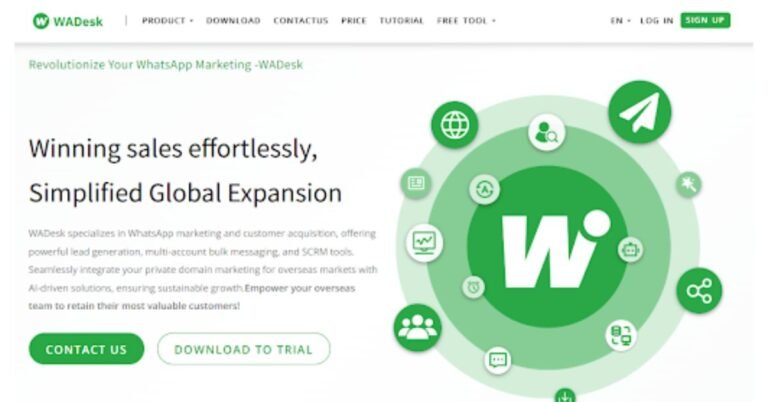“I swear I wasn’t sending ads—just a holiday greeting! Why was my account banned out of nowhere?”
If you’re running operations overseas, this kind of frustration probably sounds all too familiar. You’ve only had the account for a few days, your content seems totally compliant, and your tone is measured—yet you still get flagged. Account bans on WhatsApp are starting to feel like a game of chance: you never know when you’ll be suddenly “kicked out.”
This becomes an even bigger issue when WhatsApp is your main tool for traffic, conversions, or even your entire sales process. In that case, whether your account stays live isn’t just a minor hiccup—it directly impacts your performance and disrupts your entire team’s workflow.
“Can I do bulk messaging?” “Should we create more backup accounts?” “Is it time to try auto-replies with bots?”
Many teams only start asking these questions when they’ve already hit a wall. But in reality, the issue isn’t what you did—it’s whether you had your account properly warmed up before doing it.
Don’t wait until you’re banned to start fixing the problem.
Start taking account warming seriously now, and you could save yourself a ton of hassle and wasted effort later.
So next, let’s look at how WhatsApp actually decides whether you’re violating the rules—and how you can take a smarter, more scientific approach to warming your account, so you can message with peace of mind every day.
What exactly went wrong when your account got banned?
For many operators, the first reaction after a ban is: “What rule did I break?” But WhatsApp won’t give you a clear answer. Unlike other social platforms, WhatsApp doesn’t publish a detailed “ban list.” Instead, it relies heavily on algorithms and behavioral patterns to determine whether you might be “violating” the rules.
For example:
● Adding too many contacts at once may be flagged as “unnatural social behavior”;
● A high repetition rate in messages might trigger suspicion of “mass messaging”;
● Frequently switching devices across multiple accounts could signal “bulk operations”;
● If a new account starts sending images or links right away, it gets flagged quickly.
Often, the issue isn’t that you actually broke a rule—it’s that WhatsApp thinks you’re not behaving like a normal user. You can’t see your account’s internal “reputation score,” but it’s influencing the safety of every message, every contact added, and every link you send.
That’s exactly why more and more teams are now taking account warming seriously. At its core, warming your account means earning WhatsApp’s trust.
If you’re still worried about your account getting banned out of the blue, then it’s time to let WADesk—your WhatsApp warm-up tool—take over the job of account protection and maintenance. Hand the risk over to the system—and put your focus back where it belongs: running your business.
WADesk and the “Scientific Approach to Account Warming”
WADesk is more than just a bulk messaging tool—it’s a full-chain WhatsApp operations system tailored specifically for cross-border teams. When it comes to account warming, it goes far beyond what you might expect.
✅ Intelligent Warming Mechanism
WADesk is equipped with a unique intelligent WhatsApp warm up module that simulates the behavior rhythms of real users, such as:
● Adding contacts, replying to messages, and joining groups at a natural pace;
● Proactively interacting with contacts to keep accounts active;
● Controlling daily message frequency and content type to avoid high repetition rates;
● Implementing phased behavior interventions to make the account “act like a real user.”
None of this is random—every move is based on intelligent decisions driven by the account’s current status, activity level, and behavioral history. You no longer have to guess whether an account can send messages today—WADesk makes the call and sets the pace.
✅ Clear Account Health Monitoring
Each account’s “health status” is monitored and scored in real time by the system. In your dashboard, you can instantly see which accounts are in the danger zone, which are recovering, and which are safe to use frequently.
✅ Anti-Ban Protection
WADesk automatically avoids high-risk actions, such as suspending sensitive behavior when an account is flagged. It also supports proxy binding, anti-device fingerprinting, and anti-detection strategies to protect your account from the ground up.
WADesk’s core mission is to transform “account warming” from a mystical art into a controllable systemized process—minimizing human error, ensuring more stable accounts, and making operations much more worry-free.
From Defense to Growth: WADesk, Your Trusted Ally in Private Domain Operations
WADesk has a clear mission: to transform the account warming stage of WhatsApp operations from an unpredictable trial-and-error process into a replicable, measurable, and standardized workflow. It ensures that every account meets the criteria for stable use—so your team no longer needs to live in constant fear of sudden bans.
Because only when your accounts are stable can your operations truly take off. Once the risk of bans is under control, your energy can return to where it matters most: content creation, customer engagement, and revenue growth.
And WADesk doesn’t stop at account warming.
Account stability → Content distribution → Team collaboration → Customer conversion
It connects every key link in the private domain growth chain—laying a solid foundation, accelerating execution, and supporting your operations end to end.
Smarter account management. Easier team collaboration. More opportunities waiting to be unlocked.
Start now with WADesk—rebuild your WhatsApp operations from a position of stability, and take control of your private domain growth.

